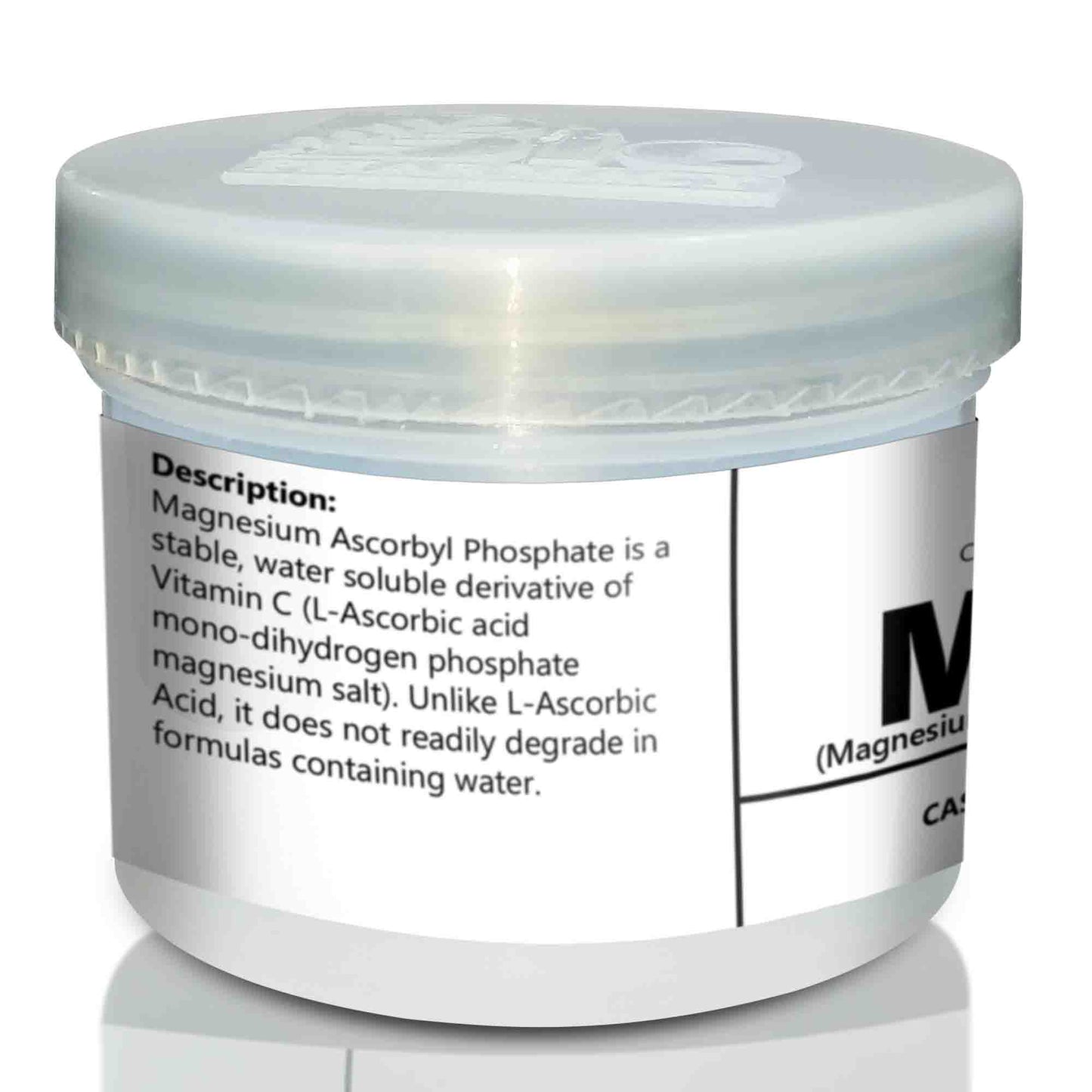Bio Shop
MAP (Magnesium Ascorbyl Phosphate)
MAP (Magnesium Ascorbyl Phosphate)
Key Functions: Acts as a brightening, antioxidant, and collagen-boosting agent in cosmetic formulations.
Couldn't load pickup availability



Explore
Information About MAP (Magnesium Ascorbyl Phosphate)
✅ Key Features
- Stable, non-irritating form of Vitamin C
- Boosts collagen production and skin firmness
- Fades dark spots and evens out skin tone
- Protects against oxidative stress and free radicals
- Water-soluble and suitable for sensitive skin
🔬 Description
MAP (Magnesium Ascorbyl Phosphate) – Stable Vitamin C Derivative for Radiant Skin
Magnesium Ascorbyl Phosphate (MAP) is a highly stable, water-soluble derivative of Vitamin C (ascorbic acid) that delivers potent antioxidant, brightening, and anti-aging benefits without the irritation commonly associated with pure Vitamin C. MAP is ideal for serums, creams, and lotions, especially for sensitive and acne-prone skin types. It promotes collagen synthesis, fades hyperpigmentation, and enhances skin’s natural radiance. MAP remains stable in a pH range of 5.0–7.0, making it compatible with most skincare systems and less prone to oxidation.
📊 Technical Data
INCI Name: Magnesium Ascorbyl Phosphate
CAS Number: 113170-55-1
Solubility: Water-soluble
Add Phase: Cool-down (below 40°C)
pH Stability: Best between 5.5 – 7.0
Processing Temperature: Below 40°C
Appearance: White to off-white powder
Odor: Odorless
Molecular Formula: C6H6O9P.Mg
Molecular Weight: 220.42 g/mol
Flash Point: Not applicable
Density: ~1.8 g/cm³
Chemical Type: Phosphorylated vitamin C derivative
Functional Groups: Phosphate ester, alcohol
Primary Cosmetic Uses: Brightening serums, anti-aging creams, sun care, sensitive skin formulations
🧪 Recommended Usage
- Usage Rate: 1% – 10%
- Phase: Add in cool-down phase (below 40°C)
- Ideal For: Serums, Creams, Eye Gels, Brightening Masks, Spot Treatments
💡 Pro Tip
🌟 To get the most from MAP, use a final pH between 5.5 and 6.5 and pair with niacinamide or panthenol for enhanced brightening and barrier support. Avoid adding to high-heat emulsions or low-pH formulas.
👩🔬 Skin Type Compatibility
✔️ Excellent for sensitive and acne-prone skin
✔️ Safe for dry, oily, combination, and mature skin types
✔️ Does not oxidize or cause stinging like ascorbic acid
🧴 Formulation Ideas
1. Daily Brightening Serum
Use 5% MAP in a hydrating base with panthenol and glycerin to fade spots and even tone.
2. Anti-Aging Day Cream
Add 3% to a peptide-rich emulsion to support collagen and fight fine lines.
3. Eye Treatment Gel
Use 2% with caffeine and niacinamide for dark circle and puffiness control.
4. After-Sun Repair Lotion
Blend 2–4% MAP with aloe vera and allantoin to reduce oxidative stress and calm redness.
5. Acne-Prone Skin Gel
Combine 5% MAP with zinc PCA and licorice extract for brightening and anti-inflammatory benefits.
💧 Cosmetic Suitability:
Serums
⭐⭐⭐⭐⭐ – Excellent
🟩🟩🟩🟩🟩 – Best form of Vitamin C for sensitive skin serums.
Creams & Lotions
⭐⭐⭐⭐☆ – Good
🟩🟩🟩🟩⬜ – Adds antioxidant and firming benefits to emulsions.
Toners
⭐⭐⭐⭐☆ – Good
🟩🟩🟩🟩⬜ – Effective in brightening and soothing mists.
Face Masks
⭐⭐⭐⭐☆ – Good
🟩🟩🟩🟩⬜ – Useful in brightening and revitalizing masks.
Cleansers
⭐⭐☆☆☆ – Fair
🟧🟧⬜⬜⬜ – Short contact time may reduce efficacy.
Hair Masks
⭐☆☆☆☆ – Poor
🟥⬜⬜⬜⬜ – Not used in hair formulations.
Deodorants
⭐☆☆☆☆ – Poor
🟥⬜⬜⬜⬜ – Not applicable.
Eye Creams
⭐⭐⭐⭐☆ – Good
🟩🟩🟩🟩⬜ – Gentle and brightening for the delicate eye area.
Shampoos
☆☆☆☆☆ – Not Suitable
🟥⬜⬜⬜⬜ – Not used in shampoos.
Soaps
☆☆☆☆☆ – Not Suitable
🟥⬜⬜⬜⬜ – Not suitable due to high pH.
Conditioners
☆☆☆☆☆ – Not Suitable
🟥⬜⬜⬜⬜ – Incompatible with hair rinse-off formulas.
Lip Balms
⭐☆☆☆☆ – Poor
🟥⬜⬜⬜⬜ – Not used in anhydrous balms.
Body Butters
⭐☆☆☆☆ – Poor
🟥⬜⬜⬜⬜ – Not waterless formula compatible.
Ointments
⭐⭐☆☆☆ – Fair
🟧🟧⬜⬜⬜ – Can be used in aqueous gel-based ointments.
❓ FAQs
Q1: Is MAP the same as pure Vitamin C?
A1: It’s a stable derivative, less potent but gentler and longer-lasting.
Q2: Can I use MAP during the day?
A2: Yes — it’s photostable and works well under sunscreen.
Q3: Is MAP good for acne-prone skin?
A3: Absolutely — it’s non-irritating, reduces inflammation, and fades acne marks.
Q4: Can it be used in oily or dry skin products?
A4: Yes — MAP is versatile and suits all skin types, especially sensitive or dry skin.
Q5: How does it compare to Sodium Ascorbyl Phosphate (SAP)?
A5: MAP is generally more stable but slightly more expensive, both are excellent choices.
📂 Documentation
Upon request, we will provide.
Where Can You Safely Use MAP (Magnesium Ascorbyl Phosphate)
Discover how MAP (Magnesium Ascorbyl Phosphate) performs across different products — rated for safety, stability, and effectiveness.




